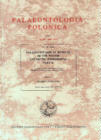| PALAEONTOLOGIA POLONICA VOL. 60 | ||
 |
Editor: |
|
|
Palaeontological
Results of the Polish |
|
|
Fostowicz-Frelik,
Ł. and Gaździcki, A. 2001. Anatomy and histology of plesiosaur bones from the Late Cretaceous of
Seymour Island, Antarctic Peninsula. In: A. Gaździcki (ed.), Palaeontological
Results of the Polish Antarctic Expeditions. Part III. Palaeontologia Polonica 60, 7–32. Abstract:
Remains
of elasmosaurid plesiosaur have been collected from the lower part of the Late
Cretaceous López de Bertodano Formation on Seymour Island, Antarctica. This
well preserved bone material includes pectoral, dorsal, and caudal vertebral
centra, femur, tibia, and fragments of the humerus, scapula, and ischia, that
most probably belong to the one specimen. The microstructure of the bone tissue
shows rather dense structure with Haversian remodelling well underway and the
areas of intensive growth, suggesting subadult stage of
ontogeny. The dense
pachyostotic character of the rib and girdle tissue, together with a relative
small size of the bones (approximated length of the animal about two meters) may
indicate that described material belongs to the not fully grown elasmosaur,
which may have lived in shallow water environment. The studied remains share
some similarities with those of Mauisaurus from the Maastrichtian of New
Zealand – in the articular surface of the vertebral centra and the shape
of the tibia. Key
words: Plesiosauria, bone histology, López de Bertodano Formation, Campanian–
Maastrichtian, Seymour Island, Antarctica. Łucja Fostowicz-Frelik [lfost@twarda.pan.pl] and Andrzej
Gaździcki [gazdzick@twarda.pan.pl], Instytut Paleobiologii PAN, Twarda 51/55,
PL-00-818 Warszawa, Poland |
|
Abstract:
Bryozoans
are a significant component of the rich biota of the Eocene La Meseta Formation
on Seymour (Marambio) Island, Antarctic Peninsula. Within the formation thirty
genera and forty-three species are recognized, of which 15 are cyclostomes and
28 are cheilostomes. Two genera and nineteen species are described as new taxa: Retecrisina
antarctica sp. n., Ceriopora hemisphaerica sp. n., Neofungella
capitula sp. n., Reptomulticava clavaeformis sp. n., Reptomulticava
seymourensis sp. n., Disporella marambioensis sp. n., Reticrescis
plicatus gen. et sp. n., Aspidostoma multiformis sp. n., Aspidostoma
pyriformis sp. n., Aspidostoma taylori sp. n., Celleporaria
australis sp. n., Celleporaria gondwanae sp. n., Celleporaria
mesetaensis sp. n., Celleporaria ovata sp. n., Dennisia eocenica
gen. et sp. n., Smittoidea gazdzickii sp. n., Aimulosia lamellosa
sp. n., Osthimosia globosa sp. n., and Rhynchozoon quadratus sp.
n. The most abundant bryozoan assemblage occurs in the transgressive facies of
the lower part of the formation (Telm1 unit). The bryozoans from the upper part
of the formation are represented by only two taxa, Reticrescis plicatus
gen. et sp. n. and Smittina sp. The following genera are herein recorded
for the first time from Antarctica: Retecrisina, Crassohornera, Borgella,
Ceriopora, Reptomulticava, Celleporaria, and Metroperiella. Others
such as Crisia, Fasciculipora, Hornera, Cellaria, Smittina, and Reteporella
have been previously noted from the Oligocene of King George Island in the South
Shetland Islands, and some of them from the Pliocene of adjacent Cockburn Island.
Most of the colonies acquired a hemispherical shape with well-marked
multilayered growth. The relationships between colony-form, growth pattern,
inferred associated biota and sedimentary structure point to a nearshore,
shallow-marine-estuarine, and wave-dominated environment for the La Meseta
Formation. The distinct differentiation of the bryozoan assemblages between the
lower part of the formation (Telm1) and upper one (Telm6–7) is most
probably connected with the climatic cooling event interpreted from the upper
part of the La Meseta Formation. Several genera such as Borgella, Neofungella,
Melicerita, Smittina, Smittoidea, Celleporaria, Aimulosia, Metroperiella,
Osthimosia, Reteporella, and Rhynchozoon have their oldest fossil
records which suggests that this area played a significant role in the evolution
of bryozoans, and from which they spread northwards before the development of
the circum-Antarctic current in the Oligocene. Key
words: Bryozoa, taxonomy, paleoecology, paleobiogeography, Eocene, Antarctica. Urszula Hara [uhar@pgi.waw.pl], Państwowy Instytut
Geologiczny, Rakowiecka 4, PL-00-975 Warszawa, Poland. |
|
Abstract:
Fifteen podocopid ostracod species, belonging to 16 genera and 9
families, are described from the Eocene La Meseta Formation of Seymour
Island, Antarctic Peninsula. Most of the taxa are left in open
nomenclature due to their rarity and/or poor state of preservation,
however two new species, i.e. ?Echinocythereis hartmanni and Majungaella
antarctica are erected. This ostracod assemblage is the first
described from the Eocene of Antarctica. The fauna suggests a
shallow-water environment and the close geographical proximity of West
Antarctica and southern Argentina in the Eocene. The paleozoogeographic
extent of the ostracod fauna indicates the existence of a marine
connection between West Antarctica, New Zealand and Australia, as well
as its bipolar exchange. Key
words: Ostracoda, taxonomy, paleoecology, paleobiogeography, Eocene,
Antarctica. Janina Szczechura [janina.s@twarda.pan.pl], Instytut
Paleobiologii PAN, ul. Twarda 51/55, PL-00-818 Warszawa, Poland. |
|
Home | Editors | Current Issue | Archive | Instructions | Subscription | History | Institute of Paleobiologyy |
|
| ©
1997-2004. Instytut Paleobiologii PAN Web Site Design by Jarosław Stolarski Last updated 04-12-09 |
Best
viewed by Internet Exlorer 4.x or higher and |